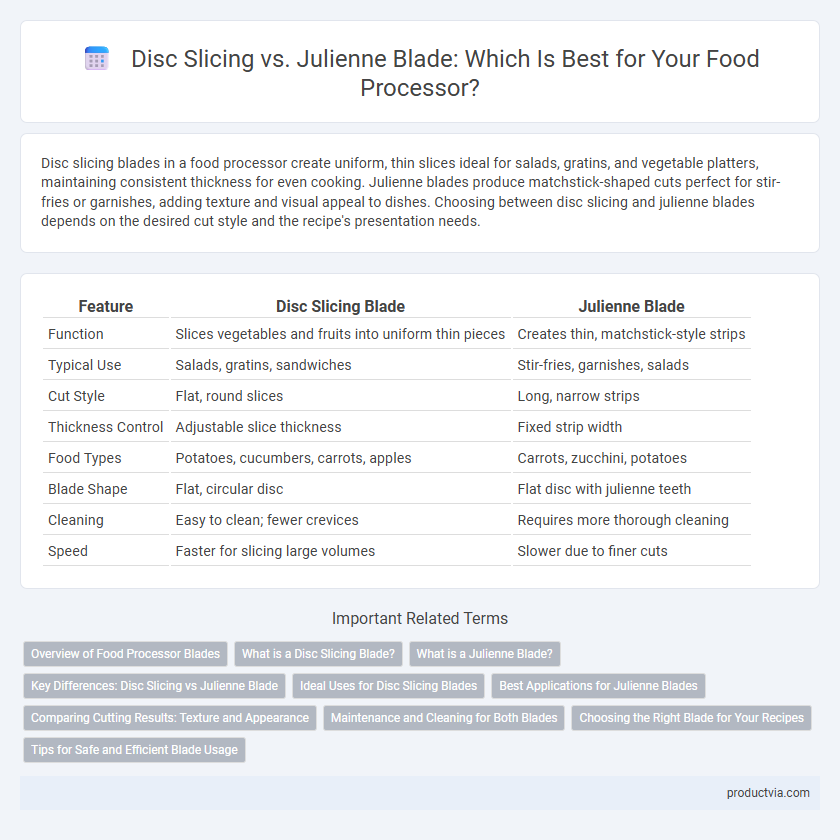Disc slicing blades in a food processor create uniform, thin slices ideal for salads, gratins, and vegetable platters, maintaining consistent thickness for even cooking. Julienne blades produce matchstick-shaped cuts perfect for stir-fries or garnishes, adding texture and visual appeal to dishes. Choosing between disc slicing and julienne blades depends on the desired cut style and the recipe's presentation needs.
Table of Comparison
| Feature | Disc Slicing Blade | Julienne Blade |
|---|---|---|
| Function | Slices vegetables and fruits into uniform thin pieces | Creates thin, matchstick-style strips |
| Typical Use | Salads, gratins, sandwiches | Stir-fries, garnishes, salads |
| Cut Style | Flat, round slices | Long, narrow strips |
| Thickness Control | Adjustable slice thickness | Fixed strip width |
| Food Types | Potatoes, cucumbers, carrots, apples | Carrots, zucchini, potatoes |
| Blade Shape | Flat, circular disc | Flat disc with julienne teeth |
| Cleaning | Easy to clean; fewer crevices | Requires more thorough cleaning |
| Speed | Faster for slicing large volumes | Slower due to finer cuts |
Overview of Food Processor Blades
Food processor blades vary primarily between disc slicing and julienne blades, each designed for specific cutting tasks to enhance meal preparation efficiency. Disc slicing blades create uniform, thin slices ideal for vegetables and fruits, while julienne blades produce matchstick-sized strips perfect for salads and garnishes. Choosing the proper blade depends on the desired food texture and presentation, optimizing the food processor's versatility and performance.
What is a Disc Slicing Blade?
A disc slicing blade in a food processor is a flat, circular attachment designed to create uniform, thin slices of vegetables, fruits, or cheeses with precision. Unlike the julienne blade, which cuts ingredients into thin, matchstick-sized strips, the disc slicing blade ensures consistent, smooth slices perfect for salads, gratins, and layered dishes. Its sharp, rotating edge allows for efficient processing, saving time and effort in food preparation.
What is a Julienne Blade?
A Julienne blade is a specialized attachment for food processors designed to cut vegetables into uniform thin strips, typically resembling matchsticks, ideal for salads and garnishes. It differs from disc slicing blades, which create flat, round slices suitable for chips or layering in dishes. Using a Julienne blade enhances presentation and ensures consistent cooking by producing evenly sized strips.
Key Differences: Disc Slicing vs Julienne Blade
Disc slicing blades in food processors create uniform, thin slices ideal for salads and garnishes, while julienne blades cut vegetables into thin, matchstick-like strips perfect for stir-fries and slaws. The disc slicing blade operates through a flat, rotating disc that cuts in a single motion, contrasted by the julienne blade's multiple sharp edges designed to produce consistent, thin strips. Understanding these key differences helps select the right blade based on the desired texture and dish preparation.
Ideal Uses for Disc Slicing Blades
Disc slicing blades in food processors are ideal for creating uniform slices of vegetables, fruits, and cheeses, perfect for salads, gratins, and stir-fries. These blades efficiently handle firm and soft produce, providing consistent thickness that enhances presentation and cooking evenness. Optimal slicing discs vary in thickness options, allowing precise control based on recipe requirements.
Best Applications for Julienne Blades
Julienne blades in food processors are ideal for creating uniform matchstick-sized strips perfect for salads, stir-fries, and garnishes. These blades excel in preparing vegetables like carrots, zucchini, and cucumbers for visually appealing, evenly cut pieces. Unlike disc slicing blades that produce wide slices, julienne blades optimize texture and presentation in dishes requiring crisp, thin strips.
Comparing Cutting Results: Texture and Appearance
Disc slicing blades produce uniform, flat slices ideal for layering and even cooking, while julienne blades create thin, matchstick-like strips that enhance texture and presentation in salads or stir-fries. The slicing disc maintains the vegetable's structural integrity, offering smooth edges and consistent thickness, whereas the julienne blade introduces a more textured, visually appealing cut with increased surface area for better sauce absorption. Choosing between these blades depends on whether the dish benefits from smooth, even slices or crisp, textured strips.
Maintenance and Cleaning for Both Blades
Disc slicing blades and julienne blades for food processors require regular cleaning to maintain sharpness and prevent food buildup. Disc slicing blades often have a flat surface that is easier to rinse quickly, while julienne blades feature multiple thin, sharp prongs that can trap food particles, necessitating more thorough scrubbing. Both blades should be hand-washed and dried immediately to prevent rust and ensure longevity, with some models offering dishwasher-safe options to simplify maintenance.
Choosing the Right Blade for Your Recipes
Disc slicing blades create uniform, thin slices ideal for salads, gratins, and vegetable chips, while julienne blades produce long, matchstick-like strips perfect for stir-fries and garnishes. Selecting the right blade depends on the desired texture and presentation of your dish, with slicing discs providing smooth, even cuts and julienne blades adding a crisp, decorative element. High-quality stainless steel blades ensure precision and durability, enhancing the efficiency of your food processor for diverse culinary applications.
Tips for Safe and Efficient Blade Usage
Using the correct blade blade in a food processor enhances safety and efficiency; the disc slicing blade is ideal for uniform slices while the julienne blade creates matchstick cuts quickly. Always ensure blades are securely locked in place before operation and avoid applying excessive pressure to prevent jamming or blade damage. Clean blades immediately after use with a brush to remove food particles, and store them safely to maintain sharpness and avoid injury.
Disc slicing vs Julienne blade for Food processor Infographic

 productvia.com
productvia.com